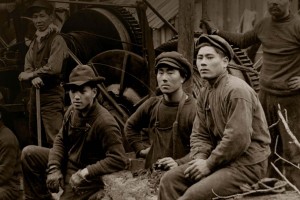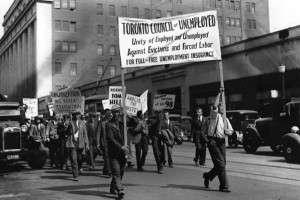Imagine being limited to working part-time hours at a job so dangerous it threatened your life every day. Imagine your family suffering continuous hunger and deprivation, all because the company you worked for only paid you $3.65 a day while charging you exorbitant rates for your lodging, utilities and household necessities, which it administered. Does it sound like labour conditions in the 18th century? Consider this: it was also the reality for vast numbers of Nova Scotian coal miners for the first 25 years of the 20th century.
The year 1925 was a turning point or, rather, a breaking point for these unionized workers, and the moment of rupture can be isolated to a single event on June 11.
Leo McKay, a longtime organizer of the annual Davis Day memorial gathering in Stellarton, Nova Scotia, explains the moment that changed mining: "Davis Day is a day set aside to honour the memory of Bill Davis, a coal miner in New Waterford, Cape Breton, who was shot dead on June 11 by company police during a strike in 1925." The mining company, BESCO (the British Empire Steel Corporation), had earlier demanded that the workers, already struggling for decent pay and working conditions, accept a 20 per cent wage reduction, expecting them to accept out of desperation. "The company just announced they were going to cut wages, take it or leave it," says McKay, "and the men walked out en masse" in response to their union's call.
DESPERATE MINERS
On June 4, after trying to no avail to get government intervention on behalf of the increasingly desperate miners and their families, the United Mine Workers of America called out the last of the maintenance men from BESCO's power plant at Waterford Lake, which would mean the mines would start to fill up with water. When company officials refused to leave the plant, writes David Frank in the book J.B. McLachlan: A Biography, they were driven out later in the day by the miners. "The shutdown broke off water and power supply to the town of Waterford," writes Frank. "The company rejected the mayor's proposal for an emergency pumping station. A union committee was mobilized to keep the hospital supplied from local wells."
On June 11, 1925, the company sent a special force to take back control of the power plant from the miners. Word spread and a huge crowd of miners and their families, many close to starvation, walked out to the Waterford Lake power plant and, when they "approached the fence surrounding the power plant," writes Frank, the company police began to shoot. "The company had hired a bunch of private police," says McKay, "and they decided they were going to break up this demonstration. They pulled guns, and Bill Davis, who was among the group, was shot dead, right on the spot."
CAPE BRETON MINERS' MUSEUM
According to the Cape Breton Miners Museum website, the miners then "swarmed the power plant, overpowered the company police and marched them off to the town jail" before feeding their families with food taken from the "company stores." The stores, long a symbol of oppression, were finally burned down by the striking workers, never to re-open after what became known as "the coal wars."
McKay, who was executive secretary with the Nova Scotia Federation of Labour for 30-plus years, says miners across the province were outraged at the death of Bill Davis. "He left behind a widow and a large family, so coal miners right across Nova Scotia decided that they were going to set aside a day to honour his memory. That day became Davis Day.'"
SENSE OF SOLIDARITY
While the specific events that led to Davis Day happened in the New Waterford, Cape Breton area, they inspired a sense of solidarity among miners across Nova Scotia. Indeed, miners everywhere vowed to never work again on Davis Day, and it became an unofficial holiday in mining communities, especially in Cape Breton but also in communities such as Springhill, and Stellarton.
McKay's own residence reflects Stellarton's mining heritage. "I live in one end of an old company house in Stellarton," he says. "They're not the same as they were back then, but I remember back then. I wasn't there in 25, but shortly afterwards I was, in 28." In fact, the name "Stellarton" comes from the word for a type of coal (stellarite), and McKay notes that the town was originally called Albion Mines.
He has vivid recollections of the old neighbourhoods, with company houses filled with miners and their families. "I can remember there was a carpenter shop in back of the Red Row, the neighbourhood where I live, and when winter was coming on, if you wanted a storm door, you went to the carpenter shop and ordered a storm door. The carpenters there were employees of the mining company, and they were union members as well. In fact, one of them was secretary of the Stellarton local of the UMW: Colin Jamieson."
In addition to the Red Row, McKay says there were other parts of Stellarton dominated by company houses at the time, including "the Asphalt," and the "Bullpen" (Evansville). "While the carpenters' shop was in the Red Row," he says, "the carpenters had to go out to the other
communities and do the same thing."
THE FIRST CO-OP STORE
This aspect of Stellarton/Albion Mines life may have been like other coal towns at the time, but there was also an historic first in McKay's hometown. "We were a bit different in that the company stores, the Pluck Me' stores, didn't really exist," says McKay. "The miners here formed a co-op: the first co-op store in all of Canada was in Stellarton, then called Albion Mines. The men took that idea from England, where all these colliers came from."
McKay notes that many British immigrants "were hired to come over and operate the mines for the English company that owned them," and company ownership changes were common, "just like today!"
Davis Day memorials are sombre reminders of the vast numbers of lives lost in the treacherous Nova Scotia mining industry in days gone by. McKay says many more men might have died over the years were it not for draegermen, special teams of miners trained in underground rescue operations. "Draegermen are specially trained to go into a mine in the event of an accident or explosion," says McKay. He remembers delivering newspapers to Red Row households as a boy, and how "the man in charge of the rescue equipment lived in the Red Row, just like the rest of us."
The Draeger equipment is a German-built breathing apparatus, which McKay likens to "what they use in deep-sea diving." It supplies oxygenated air to the men underground. McKay explains that one had to be a "special person" to use -- and have trust in -- the breathing apparatus.
"Once you got that equipment on you, if you walked down the mine and panicked, as people are wont to do, and if you lifted the mask off your face -- and men did that, doubting it was going to work for them -- you're dead from the gas. Some men died in that fashion." He recalls one death in 1958, where claustrophobia caused a Springhill miner to remove his mask and die on the slope into the mine. "You had to be a special person," says McKay, to be a Draegerman. "It's like a compass. If you start to doubt the compass' accuracy, you're in trouble wherever you are. Well, if you started to doubt the expertise of the people who kept the equipment in good operating order, you were in trouble, too." McKay's words are a reminder that, especially in a business as dangerous as mining, safety procedures can, and still, save lives and prevent injury.
Over the years there have been efforts to depoliticize, or, as McKay puts it, to "nice-ify" Davis Day. He notes: "At times they've tried to call it Miners' Memorial Day.' It was to take the story of miners having to go on strike against the company, and so on, away from it. While Davis Day today does honour all the workers killed in explosions and other accidents in the mines all over the province, it was in his memory that it was established." (Interestingly, in 2008, the province passed a private members' bill to retitle the day "William Davis Miners' Memorial Day.")
THE MEN WHO SACRIFICED
As an organizer of Stellarton's Davis Day events during his years on Stellarton Town Council, McKay says he made sure people knew it wasn't just about dry historical facts, but about actual human beings, beginning with Bill Davis himself. "The thing I always tried to promote was that it was the ordinary guy, as represented by Bill Davis, who made the thing what it was. He was what had to be remembered. These were the men who made the wheels turn, you know, and who sacrificed." McKay draws a parallel that some may find controversial when he adds, with reference to the original New Waterford miners' strike: " If you march in front of a bunch of armed police, you know, that's the same as war. There's no difference between that and going to the front lines in France, in my opinion, because the chance of being shot was equally real. Strikes became wars."
After all his time organizing Stellarton's local Davis Day, McKay says he's now, at the age of 82, handing the reins to a man who can well appreciate the on-going relevance of the memorial: Jim "Bo" Linthorne. "Jimmy was with his father in the coal face of Thorburn, Pictou County's MacBean Mine when his father was killed in the big main mine," recounts McKay. "He grabbed the chance" when it came to coordinating Davis Day. Linthorne is taking over a job that McKay gave up in 2008, the same year he was awarded a Queen's Centennial medal and a Democracy 250 medal. Typically humble when asked the reason for the honours, McKay laughs and finally relents with a simple answer." I spent a lifetime in the labour movement, working to help people."
McKay reflects that, when it comes to Davis Day, "someday it may be forgotten." In the meantime, his son Leo Jr. is helping carry the metaphorical torch for the cause. His novel Twenty Six is named for the 26 workers killed in the coal mine explosion at Pictou County's Westray mine in 1992, and was inspired by the disaster itself. For the moment, at least, Davis Day remains a monument to labour, and to lives lost.
Melissa Keith is a former radio broadcaster and an award-winning freelance journalist. She lives in Lower Sackville, Nova Scotia.














